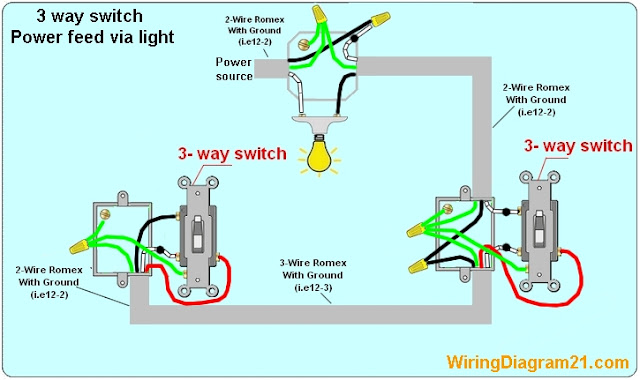

.jpg)
When the switches are installed, these wires allow electrical current to pass between the switches-or they interrupt the circuit flow to turn the light fixture off. In a circuit situation, the traveler wires typically will have black and red insulation. These are known as the traveler terminals, and the wires running between the switches are known as traveler wires. The other two screw terminals on the switch body usually are brass-colored and are used to connect the circuit wires that run between the two three-way switches. Depending on where the switch will be in the circuit layout, the purpose of this common connection is to deliver electrical current from the power source (the circuit-breaker box) either to one of the switches or to deliver the current onward from the second switch to the light fixture. The darker terminal is known as the common connection of the switch. One of the screw terminals is a darker color than the other two terminals.
3 WAY SWITCH CIRCUIT PLUS
While standard single-pole switches have two screw terminals on one side of the switch, plus a third green grounding screw terminal connected to the metal strap, three-way switches have three screw terminals plus a ground screw. The biggest difference between switch types is found in the screw terminals. This is because the switch may turn the light on or off in either position, depending on the position of the other three-way switch in the pair. Also, the switch toggle lever on a three-way does not have the ON-OFF markings found on a single-pole switch. First, the body of the switch will be thicker and bulkier than that of a single-pole switch. If you examine a three-way switch, you will notice several differences when compared to standard single-pole switches.

3-Way SwitchĪ 3-way switch can also be a 3-way dimmer switch as shown below.ģ-Way Dimmer switch Three-Way Switch Screw Terminals The three-way switch is a variation of the standard single-pole switch, which controls a light only from one location. Common scenarios would be 3-way switches located at both the top and bottom of a stairway, or having 3-way switches next to doors in a room with two entry points. A 3-way switch allows you to control an electrical fixture from two separate locations.


 0 kommentar(er)
0 kommentar(er)
